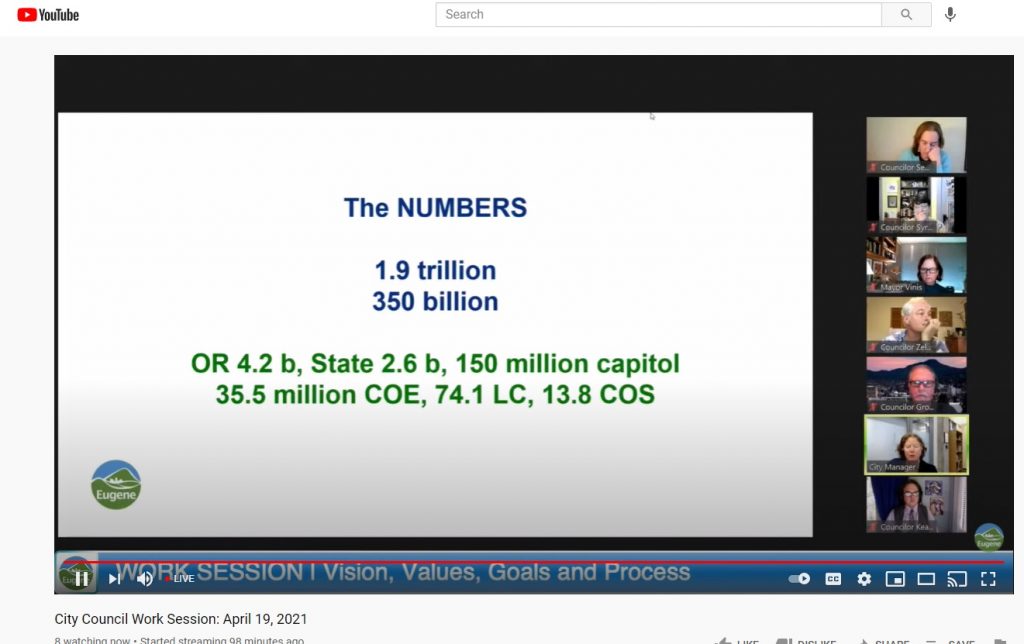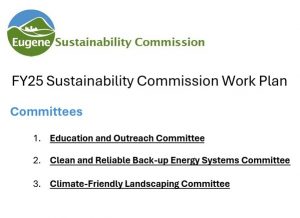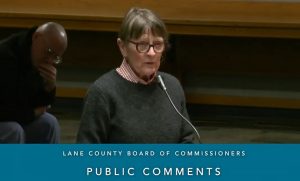Eugene expecting $35.5 million from federal ‘Rescue Plan’
3 min read
The City Manager announced that Eugene is expecting $35.5 million in federal aid.
The City of Eugene expects $35.5 million in federal help. The money may be available next month. City Manager Sarah Medary.
City Manager Sarah Medary: The American Rescue Plan Act is a $1.9 trillion act and inside of that $1.9 trillion there’s $350 billion to help states, counties, cities, and tribal governments cover increased expenditures, replenish lost revenue, and mitigate economic harm from the COVID-19 pandemic.
Oregon as a whole is going to receive about $4.2 billion, the state government an allocation of $2.6 billion. They also received a $150 million allocation for capital projects. So right now our best numbers are that we’ll receive somewhere around $35.5 million. At one time it was talked about happening in two payments, and then it was one payment. And I don’t think the criteria has been totally locked in, but $35.5 million is based on the same formula as CDBG.
Thank you for supporting
local citizen journalism
[00:01:03] So based on that formula, Lane County, last numbers I saw, were probably going to receive somewhere around $74.1 million and Springfield around $13.8 million. The rest of the cities that are smaller than 50,000 I think will get allocations; theirs will just come from the state. So some of their funding goes directly to those smaller cities. It just takes a little bit of time. We’re expecting that potentially that first payment comes in May. And we’re also expecting that the Treasury rules—so more of the criteria around what is and what isn’t acceptable to spend it on—will come in May as well.
[00:01:41] We do know that the funds can be used to respond to COVID-19 and address some of those economic impacts. We do know, Oh, and this was a really good news that it can be used for the lost revenue. So local governments across the country have lost significant revenues and have had to go to a number of scenarios to help keep things fiscally sound during that time. So we’ll be able to do that, critical infrastructure investments, specifically, they talk about water, sewer, and broadband.
[00:02:13] There’s an element that allows you to do a premium pay to essential workers. I’m not going into specifics about those details, but those are of what we know right now and that the funds will need to be spent, so need to be, but are also able to be spent until December of 2024. So there’s a lot of time.
[00:02:34] Right now our staff are working on an analysis of what those revenues are. So as we wait those final criteria, there’s a lot of work going into determining what have the impacts been and what are they can go, what do we project they’re going to continue to be over the next several years so that we can understand what it is that we’re going to need from this funding to stabilize our operations, to make sure that we’re being financially sound just based on some of the goals you just said and what we may need for an ongoing pandemic response.
[00:03:07] The numbers of what the funding has brought us as a whole lot of hope. And what we’re trying to do is get a little bit of clarity and certainty so we can understand how we can both have organizational resilience and also invest in community resilience. So our plan is, has been to finish that work and return to you with those results with, so once we have an understanding of here’s, what our impacts have been, here’s what we think they’re going to be, and here’s how these funds might work out.
[00:03:35] I checked in with a number of city managers across the state on Friday that I work with some frequency and we’re, everybody is in the same place of really needing to get through the analysis.




